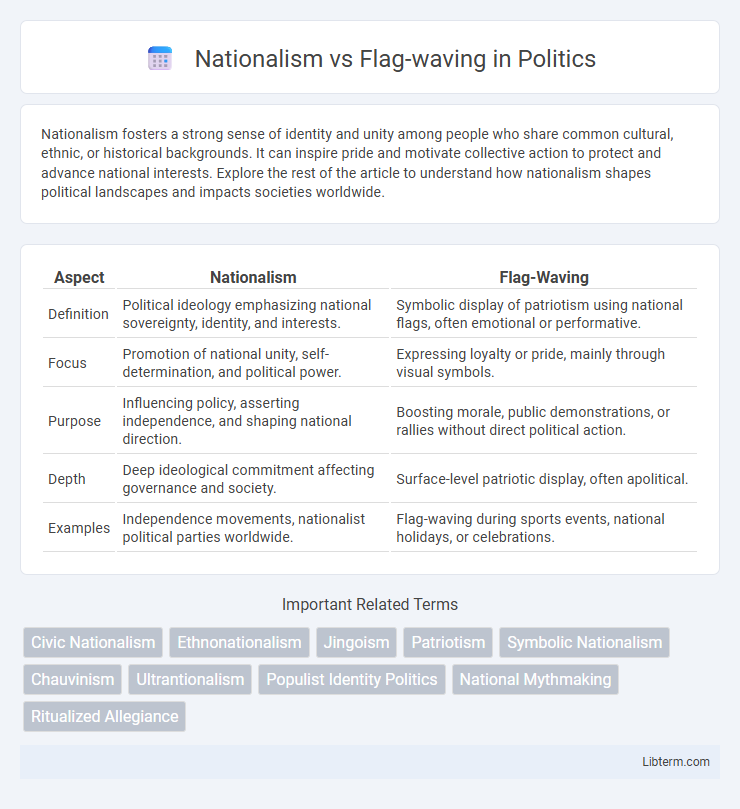Nationalism fosters a strong sense of identity and unity among people who share common cultural, ethnic, or historical backgrounds. It can inspire pride and motivate collective action to protect and advance national interests. Explore the rest of the article to understand how nationalism shapes political landscapes and impacts societies worldwide.
Table of Comparison
| Aspect | Nationalism | Flag-Waving |
|---|---|---|
| Definition | Political ideology emphasizing national sovereignty, identity, and interests. | Symbolic display of patriotism using national flags, often emotional or performative. |
| Focus | Promotion of national unity, self-determination, and political power. | Expressing loyalty or pride, mainly through visual symbols. |
| Purpose | Influencing policy, asserting independence, and shaping national direction. | Boosting morale, public demonstrations, or rallies without direct political action. |
| Depth | Deep ideological commitment affecting governance and society. | Surface-level patriotic display, often apolitical. |
| Examples | Independence movements, nationalist political parties worldwide. | Flag-waving during sports events, national holidays, or celebrations. |
Understanding Nationalism: Core Concepts
Nationalism centers on the belief in the sovereignty and unity of a nation, emphasizing shared culture, history, and values as foundational elements. Flag-waving, often perceived as a symbolic expression of patriotism, can sometimes oversimplify nationalism by focusing on outward displays rather than deeper ideological commitments. Understanding nationalism requires analyzing its role in identity formation, political movements, and the complex relationship between collective belonging and state power.
The Symbolism of Flag-waving
Flag-waving serves as a powerful symbol representing collective identity, unity, and patriotism within nationalist movements. The act of displaying a flag encapsulates shared history, cultural values, and political allegiance, making it a visual expression of national pride. While nationalism emphasizes the ideological commitment to a nation's sovereignty and cultural heritage, flag-waving distilled this sentiment into tangible symbolism that rallies community participation.
Historical Origins of Nationalism
Nationalism originated in the late 18th century during the Age of Enlightenment and the French Revolution, emphasizing the sovereignty of the people and a shared national identity. Its historical roots lie in the decline of feudalism and the rise of modern nation-states, where citizens united by language, culture, and history sought political self-determination. Flag-waving emerged as a symbolic expression of nationalism, with flags serving as powerful icons representing collective pride and unity within these evolving national communities.
Flag-waving: Tradition or Performative Act?
Flag-waving often serves as a performative act that visually conveys allegiance and group identity, yet it can also maintain deep-rooted traditions symbolizing historical struggles and national pride. While nationalism embodies the ideological commitment to a nation's sovereignty and values, flag-waving manifests this ethos through public display during ceremonies, protests, and celebrations. The dynamic between authentic patriotic expression and performative spectacle hinges on context, intent, and audience perception.
Differences Between Patriotism and Nationalism
Nationalism emphasizes a strong identification with one's nation, often involving superiority or exclusion, while flag-waving is a symbolic act of expressing allegiance often linked to both nationalism and patriotism. Patriotism centers on love and pride for one's country, promoting unity and shared values without necessarily implying dominance over others. The key difference lies in nationalism's focus on power and identity politics, contrasting with patriotism's inclusive and positive national pride.
The Role of Flags in National Identity
Flags serve as powerful symbols in shaping national identity, representing shared history, values, and collective unity among citizens. Nationalism often transforms flag-waving into a display of patriotism and allegiance, reinforcing the emotional bond between individuals and their country. This visual representation fosters a sense of belonging while occasionally sparking debates over inclusion and the political implications of national symbols.
Political Implications of Nationalism
Nationalism often fuels political agendas by emphasizing sovereignty, cultural identity, and self-determination, which can influence policy-making and international relations. Flag-waving serves as a symbolic expression of nationalist sentiment, mobilizing public support and reinforcing group cohesion during political rallies or elections. The political implications of nationalism frequently include heightened patriotism, shifts toward protectionism, and potential challenges to global cooperation.
Social Consequences of Excessive Flag-waving
Excessive flag-waving often intensifies social divisions by fostering exclusionary nationalism that marginalizes minority groups and stifles dissent. This performative patriotism can escalate xenophobia, reducing nuanced political dialogue and undermining democratic values. Such behavior also risks transforming genuine national pride into aggressive symbolism, fueling polarization and social unrest.
Nationalism in Global Contexts
Nationalism in global contexts often emphasizes the sovereignty and cultural identity of nations, promoting political unity and self-determination. It can influence international relations by fostering pride and solidarity within nations while sometimes leading to exclusionary policies or conflicts with other states. The rise of nationalism impacts globalization by challenging supranational organizations and advocating for policies that prioritize national interests over global cooperation.
Striking a Balance: Constructive National Pride
Constructive national pride fosters unity and respect without descending into exclusionary flag-waving or aggressive nationalism. Emphasizing shared values, cultural heritage, and civic responsibility helps build inclusive patriotism that promotes social cohesion and international cooperation. Striking a balance ensures national pride contributes positively to identity without fueling division or intolerance.
Nationalism Infographic

 libterm.com
libterm.com